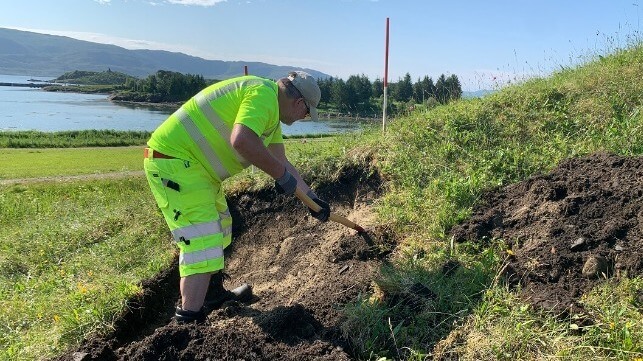Dating Confirms New Site as Scandinavia's Oldest Known Ship Burial

[By Frid Kvalpskarmo Hansen]
This summer, archaeologists and a metal detectorist conducted a small survey of Herlaugshaugen at Leka in the northern part of Trøndelag County. They found something amazing.
The goal was to date a burial mound and find out if it contained a ship. They carried out the surveys on behalf of the Norwegian Directorate for Cultural Heritage and in collaboration with Trøndelag County Authority.
The archaeologists were over the moon when they found large rivets confirming that this was indeed a ship burial, and their enthusiasm didn’t subside when the finds were recently dated.
“The mound was constructed in approximately 700 CE. This is called the Merovingian period and precedes the Viking Age. This dating is really exciting because it pushes the whole tradition of ship burials quite far back in time,” said Geir Grønnesby, an archaeologist at the NTNU University Museum.
Grønnesby was project manager for the dig. He says the date for the ship has many consequences.
You don’t build a ship of this size without having a reason for doing so.
“It tells us that people from this area were skilled seafarers – they could build big ships – much earlier than we previously thought.”
A new perspective on the Viking Age
The development of shipbuilding has played a key role in the discussion about when and why the Viking Age started. We can’t say that the Viking Age started earlier based on this dating, but Grønnesby says that you don’t build a ship of this size without having a reason for doing so.

Wood corroded tightly around a nail. Photo: Geir Grønnesby, NTNU University Museum.
“The burial mound itself is also a symbol of power and wealth. A wealth that has not come from farming in Ytre Namdalen. I think people in this area have been engaged in trading goods, perhaps over great distances.”
He is supported by archaeologist Lars Forseth from Trøndelag County Authority who also participated in the surveys this summer.
“I think that the location along the shipping route plays a key role in understanding why Herlaugshaugen burial mound is located at Leka. We know that whetstones have been traded from Trøndelag to the continent from the mid-700s onwards, and goods transport along the route is key to understanding the Viking Age and developments in ship design before the Viking Age,” Forseth said.
A seated skeleton and sword in Herlaugshaugen burial mound
The Herlaugshaugen burial mound has a diameter of over 60 meters and is one of the largest burial mounds in Norway.
 Three grave mounds photographed in Bertnem in the 1920s. Photo: Theodor Petersen.
Three grave mounds photographed in Bertnem in the 1920s. Photo: Theodor Petersen.
The mound was excavated three times during the late 1700s, and according to the accounts that exist, some kind of wall, iron rivets, a bronze cauldron, animal bones and a seated skeleton with a sword were found.
The skeleton was exhibited for a while at Trondheim Cathedral School as King Herlaug, but no one knows what happened to it.
“Unfortunately, these finds disappeared in the early 1920s. The skeleton was exhibited for a while at Trondheim Cathedral School as King Herlaug, but no one knows what happened to it,” Grønnesby said.
“All the other finds have also disappeared. It is said that the bronze cauldron was melted down and made into shoe buckles,” he said.
Connections to the power elite in Sweden and England
The Herlaugshaugen burial mound has been dated to the Merovingian Period (ca. 550 to 800 CE), which is just before the Viking Age. Generally speaking, not many archaeological finds are made from this period, but the first ship burials occurred during its early stages. Among these are the spectacular ship burials at Vendel and Valsgärde in Sweden, where people were buried lying on down pillows with ornate weapons and helmets.
Could there have been a connection between the ruling class at Vendel and Valsgärde and the people who built the burial mound at Leka?
That is not an unreasonable assumption: Not far from Leka – further into Namdalen valley – there are even more large burial mounds, which archaeologists believe are from the Merovingian Period.
“In fact, about 10 percent of all the large burial mounds in Norway are found in Namdalen. These are mounds of more than 37 meters in diameter, and it is almost inexplicable that an anonymous valley in Norway appears to be a key area for large-scale burial-mound building,” says Lars Forseth.
“We don’t know what these large mounds contain because hardly any of them have been investigated. But archaeologists have wondered for a very long time whether there is a connection between Namdalen and the areas of Vendel and Valsgärde in Sweden,” Grønnesby said.
 One of the ship nails after it has been cleaned up by University Museum conservators. Photo: Freia Beer, NTNU University Museum
One of the ship nails after it has been cleaned up by University Museum conservators. Photo: Freia Beer, NTNU University Museum
Grønnesby adds that Vendel and Valsgärde also have similarities with the fantastically rich ship burial in Sutton Hoo in England. The Sutton Hoo burial is also dated to the Merovingian Period, and is considered the oldest monumental ship burial.
“Should the ship in Herlaugshaugen burial mound be seen in connection with the burial mounds in Namdalen, Vendel, Valsgärde and Sutton Hoo, or is it a different phenomenon? This is a very exciting question, and something we want to explore further,” says Grønnesby.
This article appears courtesy of Gemini News and may be found in its original form here.
The opinions expressed herein are the author's and not necessarily those of The Maritime Executive.
